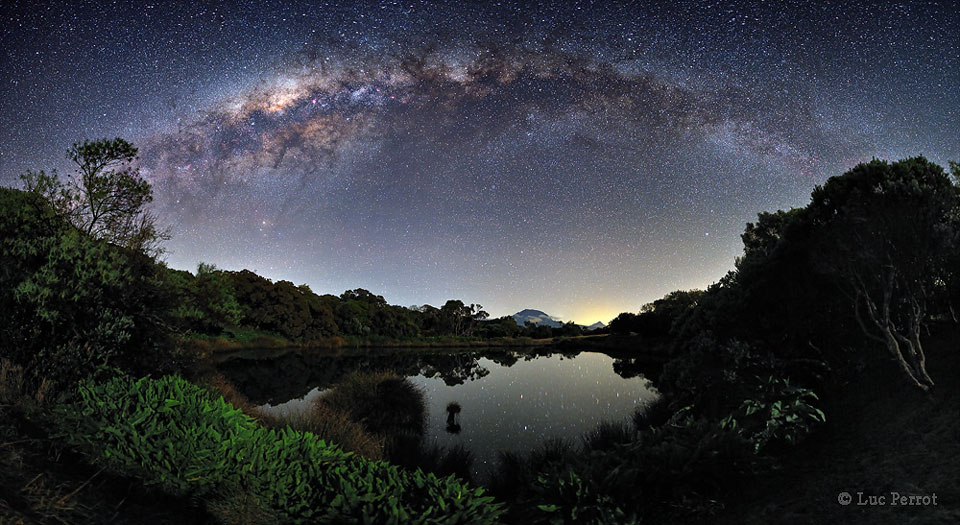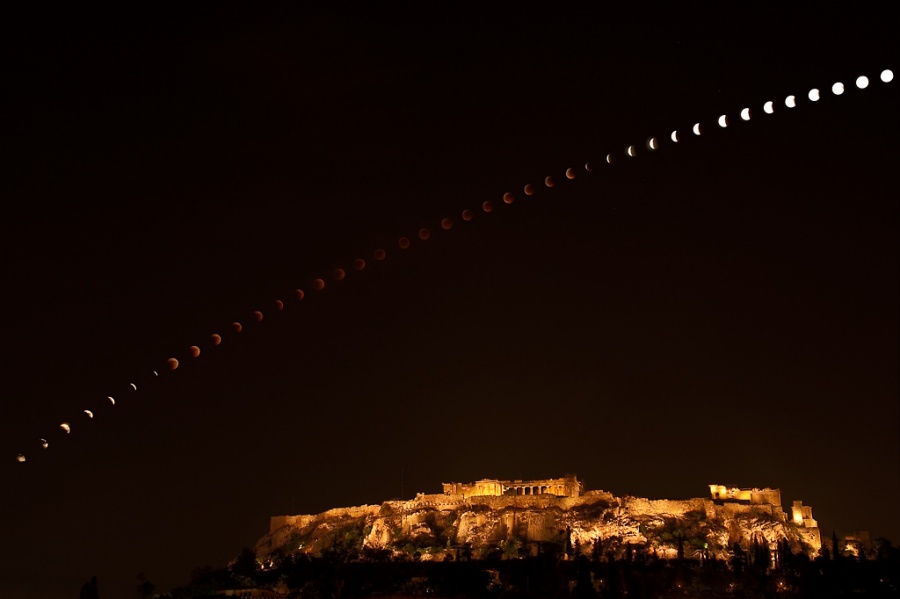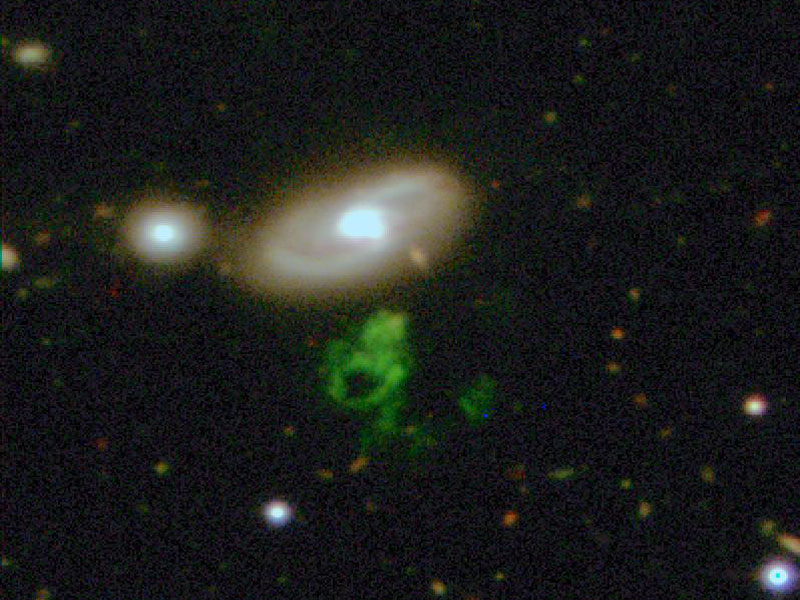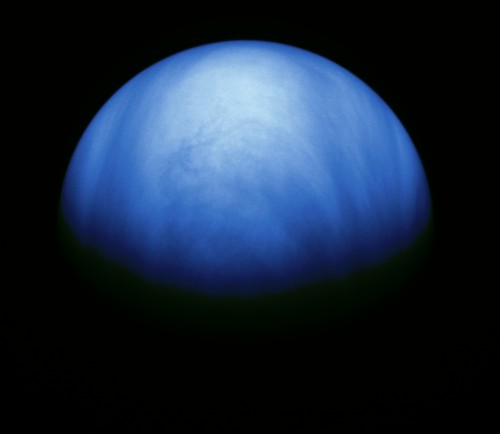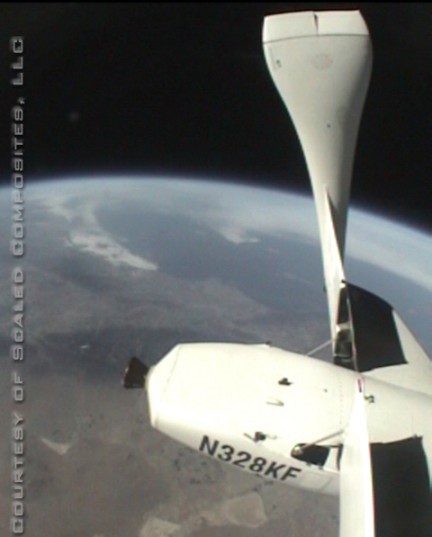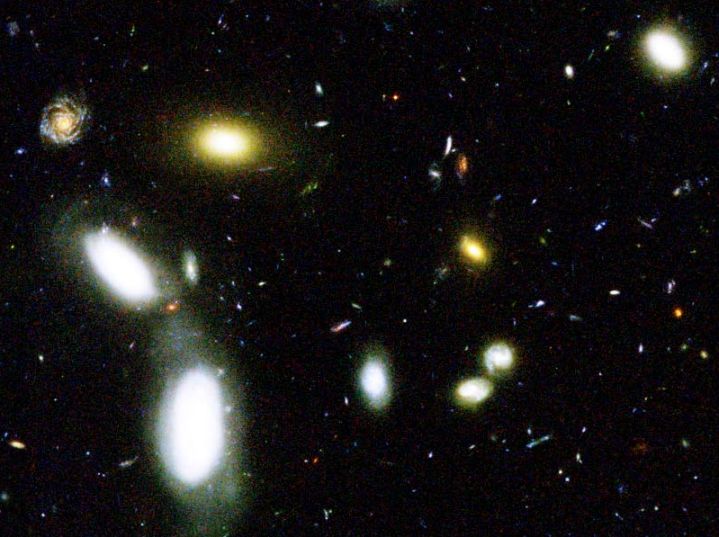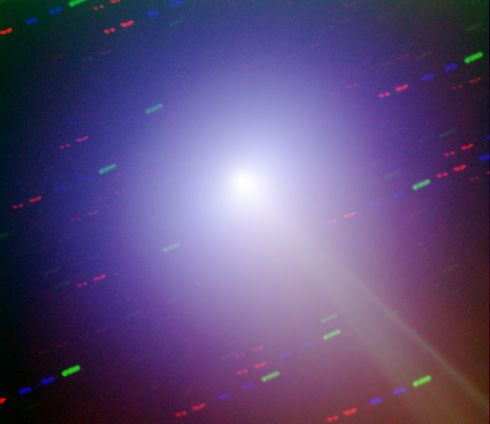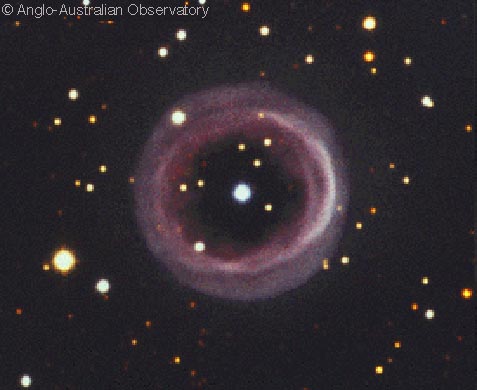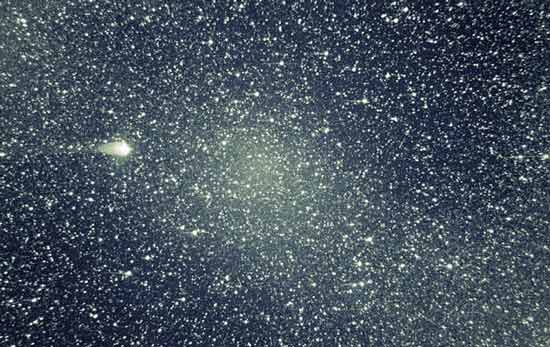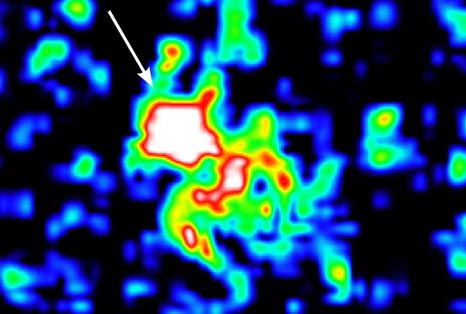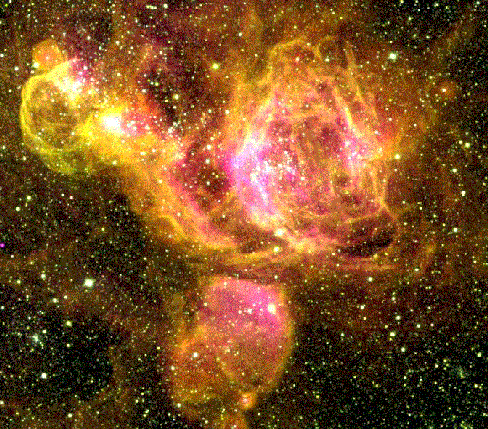| << Previous | Index | Next >> |
2015 Stars trail above and urban lights sprawl below in this moonlit nightscape from Cape Town, South Africa, planet Earth. The looming form of Table Mountain almost seems to hold terrestrial lights at bay while the stars circle the planet's South Celestial Pole. This modern perspective on the natural night sky was captured in June 2014, the scene composed of over nine hundred, stacked 30 second exposures. The stunning result was chosen as the winner in the Against the Lights category, a selection from over 800 entries in The World at Night's 2015 International Earth and Sky Photo Contest.
2014 These are galaxies of the Hercules Cluster, an archipelago of island universes a mere 500 million light-years away. Also known as Abell 2151, this cluster is loaded with gas and dust rich, star-forming spiral galaxies but has relatively few elliptical galaxies, which lack gas and dust and the associated newborn stars. The colors in this remarkably deep composite image clearly show the star forming galaxies with a blue tint and galaxies with older stellar populations with a yellowish cast. The sharp picture spans about 3/4 degree across the cluster center, corresponding to over 6 million light-years at the cluster's estimated distance. Diffraction spikes around brighter foreground stars in our own Milky Way galaxy are produced by the imaging telescope's mirror support vanes. In the cosmic vista many galaxies seem to be colliding or merging while others seem distorted - clear evidence that cluster galaxies commonly interact. In fact, the Hercules Cluster itself may be seen as the result of ongoing mergers of smaller galaxy clusters and is thought to be similar to young galaxy clusters in the much more distant, early Universe.
2013 This is Mars -- have a look around. More specifically, this is one area picked for its promise of holding clues to the habitability of Mars to ancient life. To better search for telling leads, the robotic Curiosity rover took a series of detailed images from a location called Rock Nest. Over 900 of these images were then composed into one of the highest resolution images ever created of the red planet -- a composite containing over one billion pixels. Shown above, toward the middle of this image mosaic, is Mt. Sharp, the central peak of the large crater where the Curiosity rover landed and is currently exploring. An interactive and zoomable version of this image is available here. Over the next few years, Curiosity is scheduled to roll toward the peak of ancient Mt. Sharp, all the while keeping a lookout for distinguishing geological and chemical markers.
2012 Sometimes, if you wait long enough for a clear and moonless night, the stars will come out with a vengeance. One such occasion occurred earlier this month at the Piton de l'Eau on Reunion Island. In the foreground, surrounded by bushes and trees, lies a water filled volcanic crater serenely reflecting starlight. A careful inspection near the image center will locate Piton des Neiges, the highest peak on the island, situated several kilometers away. In the background, high above the lake, shines the light of hundreds of stars, most of which are within 100 light years, right in our stellar neighborhood. Far in the distance, arching majestically overhead, is the central band of our home Milky Way Galaxy, shining by the light of millions of stars each located typically thousands of light years away. The astrophotographer reports waiting for nearly two years for the sky and clouds to be just right to get the above shot.
2011 The total phase of the June 15 lunar eclipse lasted an impressive 100 minutes. Its entire duration is covered in this composite of a regular sequence of digital camera exposures, tracking the dark lunar disk as it arced above the Acropolis in Athens, Greece. In fact, around 270 BCE Greek astronomer Aristarchus also tracked the duration of lunar eclipses, though without the benefit of digital clocks and cameras. Still, using geometry, he devised a simple and impressively accurate way to calculate the Moon's distance, in terms of the radius of planet Earth, from the eclipse duration. A more modern Greek astronomer, Elias Politis titled this eclipse duration study and the accompanying youtube timelapse video "Acropoclipse".
2010
[imghover6=http://apod.nasa.gov/apod/image/1006/Alamut-Babak2.jpg]http://apod.nasa.gov/apod/image/1006/Al ... labels.jpg[/imghover6]Image Credit & Copyright: Babak Tafreshi (TWAN)
2009 From 400 kilometers above planet Earth, the Expedition 20 Crew onboard the International Space Station (ISS) was able to witness a remarkable event from a remarkable vantage point -- the June 12 eruption of the Sarychev Peak Volcano. The active volcano is located in Russia's Kuril Island chain, stretching to the northeast of Japan. Emphasizing the orbital perspective, this stunning color stereo view was made by combining two images from the ISS and is intended to be viewed with red/blue glasses (red for the left eye). Punching upwards into the atmosphere at an early stage of the eruption, the volcanic plume features a brown column of ash topped with a smooth, bubble-like, white cloud that is likely water condensation. Below, a cloud of denser grey ash slides down the volcanic slope. About 1.5 kilometers of the island coastline is visible at ground level. The evolving ash plume posed no danger to the Expedition 20 crew, but commercial airline flights were diverted away from the region to minimize the danger of engine failures from ash intake.
2008 What is that green thing? A volunteer sky enthusiast surfing through online Galaxy Zoo images has discovered something really strange. The mystery object is unusually green, not of any clear galaxy type, and situated below relatively normal looking spiral galaxy IC 2497. Dutch schoolteacher Hanny van Arkel, discovered the strange green "voorwerp" (Dutch for "object") last year. The Galaxy Zoo project encourages sky enthusiasts to browse through SDSS images and classify galaxy types. Now known popularly as Hanny's Voorwerp, subsequent observations have shown that the mysterious green blob has the same distance as neighboring galaxy IC 2497. Research is ongoing, but one leading hypothesis holds that Hanny's Voorwerp is a small galaxy that acts like a large reflection nebula, showing the reflected light of a bright quasar event that was visible in the center of IC 2497 about 100,000 years ago. Pictured above, Hanny's Voorwerp was imaged recently by the 2.5-meter Isaac Newton Telescope in the Canary Islands by Dan Smith, Peter Herbert and Chris Lintott (Univ. Hertfordshire). Other collaboration members include Matt Jarvis, Kevin Schawinski, and William Keel.
2007 The developing International Space Station (ISS) has changed its appearance again. During the past week, the Space Shuttle Atlantis visited the ISS and added pieces of the Integrated Truss Structure that mirrored those added in September 2006, including a second impressively long array of solar panels. The entire array of expansive solar panels are visible at the edges of the above image taken by the Shuttle Atlantis Crew after leaving the ISS to return to Earth. The world's foremost space outpost can be seen developing over the past several years by comparing the above image to past images. Also visible above are many different types of modules, a robotic arm, another impressive set of solar panels, and a supply ship. Construction began on the ISS in 1998.
2006 It looked like a ring on the sky. Hundreds of years ago astronomers noticed a nebula with a most unusual shape. Now known as M57 or NGC 6720, the gas cloud became popularly known as the Ring Nebula. It is now known to be a planetary nebula, a gas cloud emitted at the end of a Sun-like star's existence. As one of the brightest planetary nebula on the sky, the Ring Nebula can be seen with a small telescope in the constellation of Lyra. The Ring Nebula lies about 4,000 light years away, and is roughly 500 times the diameter of our Solar System. In this recent picture by the Hubble Space Telescope, dust filaments and globules are visible far from the central star. This helps indicate that the Ring Nebula is not spherical, but cylindrical.
2005 Venus, the second closest planet to the Sun, is by far the brightest of the three planets gathered in this weekend's western sky at sunset. It has also proven to be a popular way-point for spacecraft headed for the gas giant planets in the outer reaches of the solar system. Why visit Venus first? Using a gravity assist maneuver, spacecraft can swing by planets and gain energy during their brief encounter, saving fuel for use at the end of their long interplanetary voyage. This colorized image of Venus was recorded by the Jupiter-bound Galileo spacecraft shortly after its gravity assist flyby of Venus in February of 1990. Galileo's glimpse of the veiled planet shows structure in swirling sulfuric acid clouds. The bright area is sunlight glinting off the upper cloud deck.
2004 On June 21st, pilot Mike Melvill made a historic flight in the winged craft dubbed SpaceShipOne -- the first private manned mission to space. The spaceship reached an altitude of just over 62 miles (100 kilometers) on a suborbital trajectory, similar to the early space flights in NASA's Mercury Program. So, how was the view? A video camera on an earlier test flight that climbed 40 miles recorded this picture looking west over the southern California coast and the Earth's limb. In the foreground, the nozzle of SpaceShipOne's hybrid rocket is visible along with the edge of the wing in a "feathered" configuration for reentry. SpaceShipOne was designed and built by Burt Rutan and his company Scaled Composites to compete for the 10 million dollar X Prize.
2003 This tantalizing view of galaxies scattered near and far is part of the Hubble Space Telescope's contribution to the GOODS - the Great Observatories Origins Deep Survey project. The GOODS' goal is to study galaxy formation and evolution over an unprecedent wide range of cosmic distances, therefore spanning time from the present to the early Universe. Joined by the Chandra X-ray Observatory and soon by the anticipated Space Infrared Telescope Facility along with major ground-based observatories, the project expands greatly on the past Hubble Deep Fields of regions in the northern constellation of Ursa Major and southern constellation Tucana. Across the electromagnetic spectrum, a sample of large nearby galaxies, like the interacting pair at the lower left above, will be compared with distant younger galaxies in a search for clues to the origins of these lighthouses of the cosmos. Preliminary results of the project confirm that the birth rate of stars was higher in the past and that galaxies have indeed been constructed from the "bottom up", growing from mergers and accretion of small infant galaxies to their present day forms.
2002 Venus and Jupiter appeared to glide right past each other earlier this month. In a slow day-by-day march, Jupiter sank into the sunset horizon while Venus remained high and bright. The conjunction ended the five-planet party visible over the last two months. Jupiter, of course, is much further away from the Earth and Sun than Venus, so the passing was really just an angular illusion. Pictured above on June 3, a fading sunset finds Venus shining over Jupiter above clouds, mountains, and the city lights of Belfast, Northern Ireland.
2001 Brighter than ever expected, comet LINEAR -- you know, the one designated C/2001 A2 -- is a sight to see in southern skies. This comet LINEAR first brightened impressively in late March as its active nucleus began to fragment, prompting some speculation that the comet might soon break up completely. But still hanging together after its closest approach to the Sun, C/2001 A2 suddenly brightened again and was reported last week to have reached nearly 3rd magnitude, easily visible to the unaided eye. This delightful telescopic picture of the brighter coma of comet LINEAR was recorded from Australia on June 20. Stars seen through the tenuous coma and filamentary tail appear as a series of short trails in this three-color composite image registered on the comet. North is up and the scene covers about half the width of the full Moon. Now moving through the constellation Cetus, comet LINEAR will be north of the celestial equator by July 4 as it comes into view for eager northern sky-gazers.
2000 What happens when a star runs out of nuclear fuel? The center condenses into a white dwarf while the outer atmospheric layers are expelled into space and appear as a planetary nebula. This particular planetary nebula, designated Shapley 1 after the famous astronomer Harlow Shapley, has a very apparent annular ring like structure. Although some of these nebulae appear like planets on the sky (hence their name), they actually surround stars far outside our Solar System.
1999 If you look carefully enough, you can even see the glow of the Sun in the opposite direction. At night this glow is known as the gegenschein (German for "counter glow"), and can be seen as a faint glow in an extremely dark sky, as pictured above. The gegenschein is sunlight back-scattered off small dust particles. These dust particles are millimeter sized splinters from asteroids and orbit in the ecliptic plane of the planets. The gegenschein is distinguished from zodiacal light by the high angle of reflection. At day, a phenomenon similar to the gegenschien called the glory can be seen in clouds opposite the Sun from an airplane.
1998 This strangely distorted galaxy of stars is cataloged as NGC 4650A. It lies about 165 million light-years away in the southern constellation Centaurus. The complex system seems to have at least two parts, a flattened disk of stars with a dense, bright, central core and a sparse, sharply tilted ring of gas, dust and stars. Observations show that the stars in the disk and the stars and gas in the ring really do move in two different, nearly perpendicular planes, probably as the result of a past galaxy vs. galaxy collision. The observed motions within both disk and ring also indicate the <="" a="">presence of "dark matter" - an unseen source of gravity which influences the movement of this system's visible stars. Over the decades evidence that our Universe is largely composed of such dark matter has grown while the nature of dark matter has remained a profound astrophysical mystery. The picture was constructed from images made using part of the European Southern Observatory's (ESO) new Very Large Telescope system now undergoing its testing phase.
1997 Where do gamma-ray bursts (GRBs) originate? The most powerful explosions in the universe have recently been located with record accuracy. But do GRBs occur in galaxies or out alone in deep space? This picture taken with the Hubble Space Telescope of the field surrounding GRB 970228 might provide a clue. It appears to show an extended structure to the lower right of the GRB, which is identified with an arrow. Many astronomers speculate that this extended structure is a distant galaxy, as its colors and subsequent steady emission indicate. Other astronomers worry that the extended emission is variable and so cannot be a galaxy. Astronomers hoping for more cases to study were rewarded just last Monday with a new, well-located event: GRB 970616. The location of this burst was determined by an unprecedented collaboration involving the tandem use of NASA satellites Compton, Ulysses and Rossi.
1996 Stars sometimes form in colorful ways. Pictured above is a small region in the nearby LMC galaxy where stars are forming. After a star is born, it may do several things to energize its immediate neighborhood. It may develop a strong wind which pushes away nearby gas; it may be so hot and intense that emitted light boils away nearby dust and gas, and it may be so massive that it soon goes supernova and catapults its elements back to the interstellar medium. Astronomers study regions like this - named DEM192 - to better understand how these and other processes proceed. This picture is a composite of three separate photographs, each sensitive to only one specific color of light - a color that distinguishes a specific chemical element.
1995 Imagine a hurricane that lasted for 300 years! This picture of the planet Jupiter was taken by the Voyager 1 spacecraft as it passed the planet in 1979. Jupiter, a gas giant planet with no solid surface, is the largest planet in the solar system and is made mostly of the hydrogen and helium. Clearly visible in the photo is the Great Red Spot, a giant, hurricane-like storm system that rotates with the clouds of Jupiter. It is so large three complete Earths could fit inside it. Astronomers have observed this giant storm on Jupiter for over 300 years.
| << Previous | Index | Next >> |



